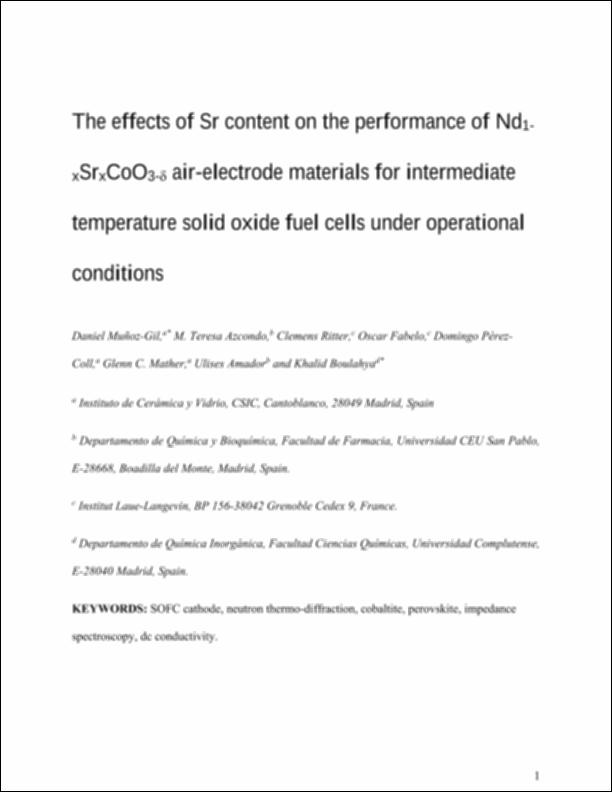Please use this identifier to cite or link to this item:
http://hdl.handle.net/10637/14793The effects of Sr content on the performance of Nd1-xSrxCoO3-δ air-electrode materials for intermediate temperature solid oxide fuel cells under operational conditions
| Title: | The effects of Sr content on the performance of Nd1-xSrxCoO3-δ air-electrode materials for intermediate temperature solid oxide fuel cells under operational conditions |
| Authors : | Muñoz-Gil, Daniel Azcondo Sánchez, María Teresa Ritter, Clemens Fabelo, Oscar Pérez-Coll, Domingo Mather, Glenn C. Amador Elizondo, Ulises Julio Boulahya, Khalid |
| Keywords: | SOFC cathode; neutron thermo-diffraction; cobaltite; perovskite; impedance spectroscopy; dc conductivity |
| Publisher: | American Chemical Society |
| Citation: | Daniel Muñoz-Gil, M. Teresa Azcondo, Clemens Ritter, Oscar Fabelo, Domingo Pérez-Coll, Glenn C. Mather, Ulises Amador, and Khalid Boulahya, The Effects of Sr Content on the Performance of Nd1–xSrxCoO3−δ Air-Electrode Materials for Intermediate Temperature Solid Oxide Fuel Cells under Operational Conditions, Inorganic Chemistry 2020 59 (17), 12111-12121 DOI: 10.1021/acs.inorgchem.0c01049 |
| Abstract: | The potential of the perovskite system Nd1-xSrxCoO3-δ (x = 1/3 and 2/3) as cathode material for solid oxide fuel cells (SOFCs) has been investigated via detailed structural, electrical and electrochemical characterisation. The average structure of x = 1/3 is orthorhombic with a complex microstructure consisting of inter-grown, adjacent, perpendicularly oriented domains. This orthorhombic symmetry remains throughout the temperature range 373-1073 K, as observed by neutron powder diffraction. A higher Sr content of x = 2/3 leads to stabilization of the cubic perovskite with a homogeneous microstructure and with higher oxygen vacancy content and cobalt oxidation state than the orthorhombic phase at SOFC operation temperature. Both materials are p-type electronic conductors with high total conductivities of 690 and 1675 S·cm-1 at 473 K in air for x = 1/3 and 2/3, respectively. Under working conditions, both compounds exhibit similar electronic conductivities, since x = 2/3 loses more oxygen on heating than x = 1/3, associated with a greater loss of p-type charger carriers. However, composite cathodes prepared with Nd1/3Sr2/3CoO3-δ and Ce0.8Gd0.2O2-δ present lower ASR values (0.10 Ω·cm2 at 973 K in air) than composites prepared with Nd2/3Sr1/3CoO3-δ and Ce0.8Gd0.2O2-δ (0.34 Ω·cm2). The high activity for the oxygen electrochemical reaction at intermediate temperatures is likely attributable to a large disordered oxygen-vacancy concentration, resulting in a very promising SOFC cathode for real devices. |
| URI: | http://hdl.handle.net/10637/14793 |
| Rights : | http://creativecommons.org/licenses/by-nc-nd/4.0/deed.es |
| ISSN: | 520-510X |
| Issue Date: | 7-Aug-2020 |
| Center : | Universidad San Pablo-CEU |
| Appears in Collections: | Facultad de Farmacia |
Items in DSpace are protected by copyright, with all rights reserved, unless otherwise indicated.


